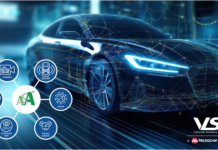
Being on the road is one of the most dangerous activities Americans regularly participate in. Despite vehicles becoming safer and smarter, traffic fatalities hit a 16-year high in 2021[i] and remained elevated through 2023. Unfortunately, making cars bigger and safer for their passengers also makes them more dangerous for everyone outside the car. Pedestrian and cyclist fatalities are the biggest contributors to the overall increase. With an eye towards safety for all, the automotive industry is embracing technology that makes smarter more synonymous with safer.
Autonomous vehicles (AVs) aim to reduce the dangers of the roads. State-of-the-art safety systems are always running and do not have the lapses in attention that human drivers do. However, AVs have a long road ahead of them before they reach widespread adoption. In addition to the in-vehicle technological challenges, there are infrastructure obstacles like poorly painted road lines that AVs will need to contend with. Aside from these more tangible challenges, there are other significant barriers to automation that engineers cannot solve in the lab—social and economic barriers.
Drive-by-Wire Skepticism
The viral “runaway Prius” story in 2010, in which the driver claimed the car accelerated out of control up to 151km/h (94mi/h), created a culture of skepticism around modern electronically controlled engines. Exactly what happened in the Prius remains a mystery, but the story became a lightning rod for the discussion about handing control of our cars over to computers.
Over ten years later, many of us have firsthand experience with advanced driver assistance systems (ADAS), and the occasionally rudimentary way in which ADAS takes control may not inspire confidence in letting the car do all the driving. Consider adaptive cruise control, where your car automatically maintains a set distance behind the car in front of you. It’s an incredible tool for long road trips until someone merges into the gap in front of you and your car ungracefully slams on the brakes.
When we’re behind the wheel, we may not always be able to comprehend the intentions of other drivers, but we at least know what our own plan is. We know when we’re going to accelerate and brake, we know which gaps we’re going to merge into, and we know our own general driving habits. ADAS creates a jarring effect when it takes over and handles things in a different way than we would have. With hundreds of thousands of miles under our belts, drivers are used to cars behaving a certain way, and any sort of change faces resistance to widespread acceptance.
More Than a Machine
We also just like our cars. When the weather is nice, collectors take to the roads to turn heads in their carefully maintained classic vehicles. Car and coffee meetups fill parking lots around cities on weekend mornings, where enthusiasts show off custom builds as unique as their personalities. Perhaps no machine holds more cultural and personal significance to Americans than the car. Cars are an embodiment of individualism and freedom, and for most Americans, the only way to get around. Countless songs and films romanticize the idea of being able to drive anywhere. My personal favorite is The Fast and the Furious: Tokyo Drift.
The reality is that people have a personal attachment to their cars and might not be eager to hand the reins over to a computer. In the short term, designers must consider that autonomous vehicles will be surrounded by human drivers.
Programming Ethics into Vehicles
Designers face the challenge of creating perfect drivers on roads full of imperfect drivers. In addition to the infamous trolley problem asking if AVs should prioritize protecting passengers over bystanders, autonomous cars will need to make everyday decisions on the road with ethical implications. If everyone on the road is going 10 above the speed limit, should an autonomous car speed too? How does an autonomous car know when it needs to assert itself to merge into heavy traffic that isn’t yielding? If two autonomous vehicles collide in the woods and nobody witnesses it, whose insurance pays out?
Human drivers make mistakes, but AVs do what they’re programmed to do. With the speed computers operate at, a split-second choice for a human driver is a deliberate and calculated decision for a computer-driven car. Regulatory authorities recognize the obligation of AVs to perform safely. In the case of the new SAE Level 3 Mercedes-Benz models, the automaker will take legal responsibility for accidents caused when the cars are driving themselves. As ADAS and autonomous features spread, the legal and regulatory fields will also need to evolve.
ADAS Needs Time to Become Standard
In May 2023, the National Highway Traffic Safety Authority (NHTSA) announced a proposed rule requiring automatic emergency braking (AEB) on all passenger cars and light trucks. If the rule is adopted by the federal government, automakers will have three years to include AEB technology on all new vehicles.[ii] Automakers have already made significant progress equipping new vehicles with AEB as part of a voluntary pledge to roll out AEB as a standard feature for the 2022 production year.[iii] However, the proposed rule would further require pedestrian AEB, as larger modern cars are becoming more dangerous for people outside the car.
AEB saves lives and reduces injuries and accidents by reacting faster than we can. However, the technology comes with a cost. According to Kelley Blue Book, the average price of a new car is over $48,000 USD.[iv] Cars packed with sensors and other electronics are particularly expensive to produce. As a result, many drivers choose not to upgrade, bringing the average age of cars on the road to a record 12.5 years in mid-2023.[v] Most cars on the road are from a time when AEB and other ADAS functions were a premium feature only available on high-end trims or luxury vehicles.
Sharing The Road
The more autonomous vehicles there are on the road, the more effective they’ll be at mitigating accidents and improving traffic flow with vehicle-to-vehicle (V2V) communication. However, it will take years for V2V to become a two-way street with many vehicles on the road. Similar to passenger airbags, anti-lock brakes, and traction control, ADAS and eventually autonomy require time to become everyday features.
In the meantime, advanced cars will need to contend with social norms and preferences in addition to the technological and infrastructure obstacles to widespread adoption.
Sources
[i] Wayland, Michael. “U.S. traffic deaths reached a 16-year high in 2021, according to government estimates.” CNBC, May 17, 2022, https://www.cnbc.com/2022/05/17/us-traffic-deaths-hit-16-year-high-in-2021-dot-says.html.
[ii] NHTSA. “NHTSA Proposes Automatic Emergency Braking Requirements for New Vehicles.” May 31, 2023, https://www.nhtsa.gov/press-releases/automatic-emergency-braking-proposed-rule.
[iii] “Three more automakers fulfill pledge to make autobrake nearly universal.” IIHS, December 8, 2022, https://www.iihs.org/news/detail/three-more-automakers-fulfill-pledge-to-make-autobrake-nearly-universal.
[iv] Tucker, Sean. “Average New Car Price Sees Smallest Increase in a Decade.” Kelley Blue Book, August 9, 2023, https://www.kbb.com/car-news/average-new-car-price-sees-smallest-increase-in-a-decade/.
[v] Parekh, Nishant and Todd Campau. “Average Age of Light Vehicles in the US Hits Record High 12.5 years, according to S&P Global Mobility.” May 15, 2023, https://www.spglobal.com/mobility/en/research-analysis/average-age-of-light-vehicles-in-the-us-hits-record-high.html.
The blog first published in Mouser Website.



















